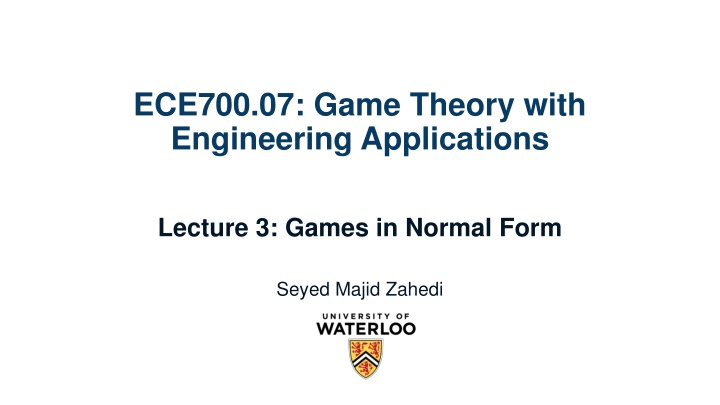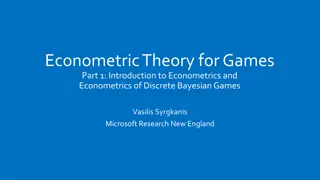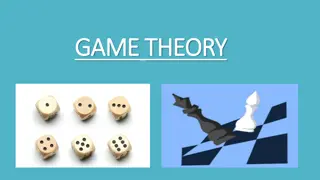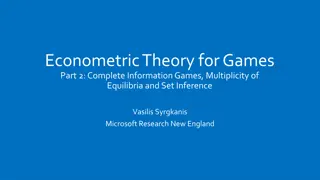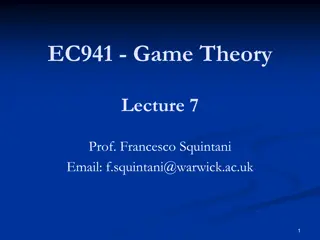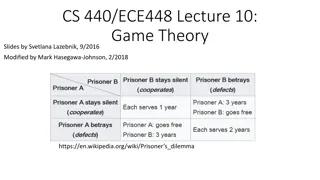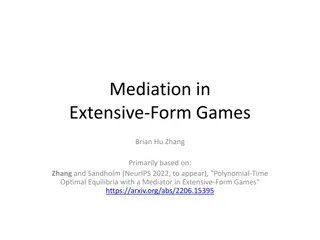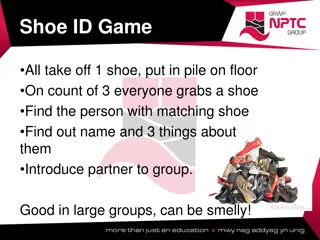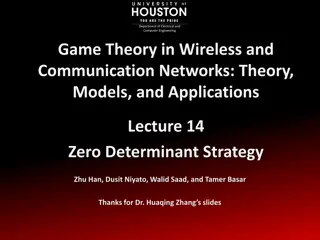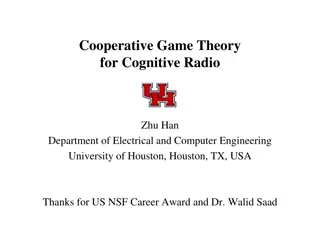Game Theory with Engineering Applications Lecture 3: Games in Normal Form
Explore the application of game theory in an engineering context with a focus on games in normal form. Understand the strategic interactions between decision-makers in various scenarios. Learn how to analyze and solve these games using mathematical tools to make informed decisions. Dive into the complexities of game theory with practical engineering applications.
Download Presentation

Please find below an Image/Link to download the presentation.
The content on the website is provided AS IS for your information and personal use only. It may not be sold, licensed, or shared on other websites without obtaining consent from the author.If you encounter any issues during the download, it is possible that the publisher has removed the file from their server.
You are allowed to download the files provided on this website for personal or commercial use, subject to the condition that they are used lawfully. All files are the property of their respective owners.
The content on the website is provided AS IS for your information and personal use only. It may not be sold, licensed, or shared on other websites without obtaining consent from the author.
E N D
Presentation Transcript
ECE700.07: Game Theory with Engineering Applications Lecture 3: Games in Normal Form Seyed Majid Zahedi
Outline Strategic form games Dominant strategy equilibrium Pure and mixed Nash equilibrium Iterative elimination of strictly dominated strategies Price of anarchy Correlated equilibrium Readings: MAS Sec. 3.2 and 3.4, GT Sec. 1 and 2
Strategic Form Games Agents act simultaneously without knowledge of others actions Each game has to have (1) Set of agents (2) Set of actions (3) Utilities Formally, strategic form game is triplet , ?? ? , ?? ? is finite set of agents ??is set of available actions for agent ? and ?? ??is action of agent ? ??:? is utility of agent ?, where ? = ???is set of all action profiles ? ?= ??? ?is vector of actions for all agents except ? ? ?= ? ???is set of all action profiles for all agents except ? (??, ? ?) ? is strategy profile, or outcome
Example: Prisoners Dilemma Prisoner 2 Stay Silent Confess Prisoner 1 Stay Silent (-1, -1) (-3, 0) Confess (0, -3) (-2, -2) First number denotes utility of A1 and second number utility of A2 Row ? and column ? cell contains ?,? , where ? = ?1?,? and ? = ?2?,?
Strategies Strategy is complete description of how to play It requires full contingent planning As if you have to delegate play to computer You would have to spell out how game should be played in every contingency In chess, for example, this would be an impossible task In strategic form games, there is no difference between action and strategy (we will use them interchangeably)
Finite Strategy Spaces When ??is finite for all ?, game is called finite game For 2 agents and small action sets, it can be expressed in matrix form Example: matching pennies Agent 2 Agent 1 Heads Tails Heads (-1, 1) (1, -1) Tails (1, -1) (0, 0) Game represents pure conflict; one player s utility is negative other player s utility; thus, zero sum game
Infinite Strategy Spaces When ??is infinite for at least one ?, game is called infinite game Example: Cournot competition Two firms (agents) produce homogeneous good for same market Agent ? s action is quantity, ?? [0, ], she produces Agent ? s utility is her total revenue minus total cost ???1,?2 = ??? ?1+ ?2 ??? ?(?) is price as function of total quantity, ? is unit cost (same for both agents)
Dominant Strategy Strategy ?? ??is dominant strategy for agent ? if ????,? ? ???? Example: prisoner s dilemma ,? ? for all s? ??and for all s ? ? ? Prisoner 2 Stay Silent Confess Prisoner 1 Stay Silent (-1, -1) (-3, 0) Confess (0, -3) (-2, -2) Action confess strictly dominates action stay silent Self-interested, rational behavior does not lead to socially optimal result
Dominant Strategy Equilibrium Strategy profile ? is (strictly) dominant strategy equilibrium if for each agent ?, s? Example: ISP routing game ISPs share networks with other ISPs for free ISPs choose to route traffic themselves or via partner In this example, we assume cost along link is one is (strictly) dominant strategy ISP 2 Route Yourself Route via Partner ISP 1 Route Yourself (-3, -3) (-6, -2) Route via Partner (-2, -6) (-5, -5)
Dominated Strategies ??: Strategy ?? ??is strictly dominated for agent ? if s? ,? ? > ????,? ?, ? ? ? ? ???? ??: Strategy ?? ??is weakly dominated for agent ? if s? ,? ? ????,? ?, ? ? ? ? ???? ,? ? > ????,? ?, ? ? ? ? ????
Rationality and Strictly Dominated Strategies Prisoner 2 Stay Silent Confess Suicide Prisoner 1 Stay Silent (-1, -1) (-3, 0) (0, -10) Confess (0, -3) (-2, -2) (-1, -10) Suicide (-10, 0) (-10, -1) (-10, -10) There is no DS because of additional suicide strategy Strictly dominated strategy for both prisoners No rational agent would choose suicide No agent should play strictly dominated strategy
Rationality and Strictly Dominated Strategies (cont.) If A1 knows that A2 is rational, then she can eliminate A2 s suicide strategy, and likewise for A2 After one round of elimination of strictly dominated strategies, we are back to prisoner s dilemma game Iterated elimination of strictly dominated strategies leads to unique outcome, confess, confess Game is dominance solvable (We will come back to this later)
How Reasonable is Dominance Solvability? Consider k-beauty contest game is dominance solvable! 100 dominated (2/3)*100 dominated after removal of (originally) dominated strategies (2/3)*(2/3)*100 0
Existence of Dominant Strategy Equilibrium Does matching pennies game have DSE? Agent 2 Heads Tails Agent 1 Heads (-1, 1) (1, -1) Tails (1, -1) (-1, 1) Dominant strategy equilibria do not always exist
Best Response ??? ? represents agent ? s best response correspondence to ? ? Example: Cournot competition ???1,?2 = ??? ?1+ ?2 ??? Suppose that ? = 1 and ? ? = max 0,2 ? First order optimality condition gives Figure illustrates best response correspondences (functions here!)
Pure Strategy Nash Equilibrium (Pure strategy) Nash equilibrium is strategy profile ? ? such that ???? ????,? ? No agent can profitably deviate given strategies of others In Nash equilibrium, best response correspondences intersect Strategy profile ? ? is Nash equilibrium iff ?? ,? ? , ?,?? ?? ??? ? , ?
Example: Battle of the Sexes Wife Football Opera Husband Football (4, 1) (-1, -1) Opera (-1, -1) (1, 4) Couple agreed to meet this evening They cannot recall if they will be attending opera or football Husband prefers football, wife prefers opera Both prefer to go to same place rather than different ones
Existence of Pure Strategy Nash Equilibrium Does matching pennies game have pure strategy NE? Agent 2 Heads Tails Agent 1 Heads (-1, 1) (1, -1) Tails (1, -1) (-1, 1) Pure strategy Nash equilibria do not always exist
Mixed Strategies Let ? denote set of probability measures over pure strategy set ?? E.g., 45% left, 10% middle, and 45% right We use ?? ? to denote mixed strategy of agent ?, and ? = ? ? to denote mixed strategy profile This implicitly assumes agents randomize independently Similarly, we define ? ? ?= ? ? ? Following von Neumann-Morgenstern expected utility theory, we have ??? = ??? ??(?) ?
Strict Dominance by Mixed Strategy Agent 2 a b Agent 1 a (2, 0) (-1, 0) b (0, 0) (0, 0) c (-1, 0) (2, 0) Agent 1 has no pure strategy that strictly dominates b 1 2,0,1 However, b is strictly dominated by mixed strategy 2 Action ?? is strictly dominated if there exists ?? such that ????,? ? > ????,? ?, ? ? ? ? Strictly dominated strategy is never played with positive probability in mixed strategy NE However, weakly dominated strategies could be used in Nash equilibrium
Iterative Elimination of Strictly Dominated Strategies 0= ?? and ? 0= ? Let ?? For each agent ?, define ?? And define ? Finally, define ?? IESDS ?? ?= ?? ?? ? 1| ?? ? ? 1: ????,? ? > ????,? ? ? ? ? ? ? 1 ?= ?? ?|???? > 0 only if ?? ?? as set of agent ? s strategies that survive ? = ?=1 ? ??
Mixed Strategy Nash Equilibrium Profile ? is (mixed strategy) Nash equilibrium if for each agent ? ,? ? , ???? ????,? ? ?? ? Profile ? is (mixed strategy) Nash equilibrium iff for each agent ? ,? ? , ???? ????,? ? ?? ? Why? Hint: Agent ? s utility for playing mix strategies is convex combination of
Mixed Strategy Nash Equilibria (cont.) For ?, finite strategic form game, profile ? is NE iff for each is best response to agent, every pure strategy in support of ?? ? ? Why? Hint: If profile ? puts positive probability on strategy that is not best response, shifting that probability to other strategies improves expected utility Every action in support of agent s NE mixed strategy yields same utility
Finding Mixed Strategy Nash Equilibrium Wife Football Opera Husband Football (4, 1) (-1, -1) Opera (-1, -1) (1, 4) Assume H goes to football with probability ? and W goes to opera with probability ? Using mixed equilibrium characterization, we have ? 1 ? = ? + 4 1 ? ? =5 7 ? 1 ? = ? + 4 1 ? ? =5 7 3 7,3 Mixed strategy Nash equilibrium utilities are 7
Example: Bertrand Competition with Capacity Constraints Two firms charge prices ?1,?2 [0,1] per unit of same good There is unit demand which has to be supplied Customers prefer firm with lower price Assume each firm has capacity constraint of 2/3 units of demand If ?1< ?2, firm 2 gets 1/3 units of demand If both firms charge same price, each gets half of demand Utility of each firm is profit they make (? = 0, for both firms)
Example: Bertrand Competition with Capacity Constraints (cont.) Without capacity constraint, ?1= ?2= 0 is unique pure strategy NE You will prove this in first assignment! With capacity constraint, ?1= ?2= 0 is no longer pure strategy NE Either firm can increase its price and still have 1/3 units of demand We consider symmetric mixed strategy Nash equilibrium I.e., both firms use same mixed strategy We use cumulative distribution function, ? , for mixed strategies
Example: Bertrand Competition with Capacity Constraints (cont.) What is expected utility of firm 1 when it chooses ?1 and firm 2 uses mixed strategy ? ? ?1 3+ 1 ? ?1 Each action in support of mixed strategy must yield same utility at NE ? in support of ? 2? 3 ? ? ? 0 ? ? = 2 3? 2?1 3 ?1?1,? = ? ?1 ? 3= ?, ?
Example: Bertrand Competition with Capacity Constraints (cont.) Note that upper support of mixed strategy must be at ? = 1, which implies that ?(1) = 1 Combining with preceding, we obtain
Nashs Theorem Theorem (Nash): Every finite game has mixed strategy NE Why is this important? Without knowing the existence of equilibrium, it is difficult (perhaps meaningless) to try to understand its properties Armed with this theorem, we also know that every finite game has at least one equilibrium, and thus we can simply try to locate equilibria Knowing that there might be multiple equilibria, we should study efficiency/inefficiency of games equilibria
Example: Braesss Paradox There are 2? drivers commuting from ? to ? ? ? indicates travel time in hours for ? drivers ? drivers going through ? and ? going through ? is NE Why? T. Roughgarden, Lectures Notes on Algorithmic Game Theory
Example: Braesss Paradox (cont.) Suppose we install teleportation device allowing drivers to travel instantly from ? to ? What is new NE? What is drivers commute time? What is optimal commute time? Does selfish routing does not minimize commute time? Price of Anarchy (PoA) is ratio between system performance with strategic agents and best possible system performance Ratio between 2 and 3/2 in Braess s Paradox
Correlated Strategies In NE, agents randomize over strategies independently Agents can randomize by communicating prior to taking actions Example: battle of the sexes Wife Football Opera Husband Football (4, 1) (-1, -1) Opera (-1, -1) (1, 4) 5 7,2 5 7,2 3 7,3 Unique mixed strategy NE is with utilities 7, 7 7 Can they both do better by coordinating?
Correlated Strategies (cont.) Suppose there is publicly observable fair coin If it is heads/tails, they both get signal to go to football/opera If H/W sees heads, he/she believes that W/H will go to football, and therefore going to football is his/her best response Similar argument can be made when he/she sees tails When recommendation of coin is part of Nash equilibrium, no agent has any incentives to deviate Expected utilities for this play of game increases to 2.5,2.5
Correlated Equilibrium Correlated equilibrium of finite game is joint probability distribution ? (?) such that ?,?? ?? with ? ?? > 0, and ?? ?? ? ? ??? ????,? ? ????,? ? 0 ? ? ? ? Distribution ? is defined to be correlated equilibrium if no agent can benefit by deviating from her recommendation, assuming other agents play according to their recommendations
Example: Game of Chicken S D D S Driver 2 S D Driver 1 S (-5, -5) (1, -1) D (-1, 1) (0, 0) (D, S) and (S, D) are Nash equilibria They are pure-strategy Nash equilibria: nobody randomizes They are also strict Nash equilibria: changing strategy will make agents strictly worse off
Example: Game of Chicken (cont.) Driver 2 S D Driver 1 S (-5, -5) (1, -1) D (-1, 1) (0, 0) Assume D1 dodges with probability ? and D2 dodges with probability ? Using mixed equilibrium characterization, we have ? 5 1 ? = 0 1 ? ? =4 5 ? 5 1 ? = 0 1 ? ? =4 5 1 5, 1 Mixed strategy Nash equilibrium utilities are , people may die! 5
Example: Game of Chicken (cont.) Is this correlated equilibrium? If D1 gets signal to dodge Conditional probability that D2 dodges is Driver 2 S D Driver 1 (-5, -5) (1, -1) S 0% (-1, 1) 40% (0, 0) 0.2+0.4=1 0.2 D 40% 20% 3 2 3 1 Expected utility of dodging is 1 3 1 + 2 3 5 = 3 Expected utility of going straight is Following recommendation is better If D1 gets signal to go straight, she knows that D2 is told to dodge, so again, D1 wants to follow recommendation Similar analysis works for D2, so nobody dies! Expected utilities increase to (0,0)
Characterization of Correlated Equilibrium Proposition Joint distribution ? (?) is correlated equilibrium of finite game iff ?(?) ????,? ? ????,? ? 0, ?,??,?? ?? ? ? ? ? Proof By definition of conditional probability, correlated equilibrium can be written as ?(??,? ?) 0, ?, ?? ?? with ?(??) > 0, and ?? ? ? ? ? ????,? ? ????,? ? ? ? ? ?? ??,? ? Denominator does not depend on variable of sum, so it can be factored and cancelled If ?(??) = 0, then LHS of Proposition is zero regardless of ? and ??, so equation always holds
Acknowledgement This lecture is a slightly modified version of ones prepared by Asu Ozdaglar [MIT 6.254] Vincent Conitzer [Duke CPS 590.4]
